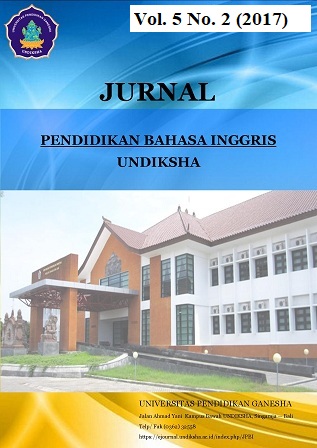The Morphological Processes of Balinese Dialect Spoken by Timbrah Villagers
DOI:
https://doi.org/10.23887/jpbi.v5i2.13329Abstract
Penelitian ini bertujuan untuk mengetahui adanya proses pembentukan kata yang terjadi pada bahasa Bali yang digunakan di desa Timbrah. Penelitian ini merupakan Deskriptif Kualitatif. Dalam pengumpulan data, penelitian ini menggunakan metode observasi dan metode interview. Data dikumpulkan berdasarkan 3 domain, yaitu: keluarga, pertemanan dan lingkungan. Peneliti mengumpulkan data berdasarkan prosedur penelitian menggunakan data analisis oleh Miles dan Huberman (1994). Objek penelitian ini adalah proses pembentukan kata bahasa bali pada desa timbrah. Adapun 2 macam dari proses morfologi yaitu: awalan dan akhiran. Adapun 6 pembentukan kata yaitu: gabungan kata, pengulangan kata, campuran kata, pemotongan kata, peminjaman kata dan akronim. Hasil penelitian ini menunujukan adanya tiga jenis awalan yang merupakan proses pembentukan suatu jenis kata {me-}, {N-} allomorph |ny| and {N-} allomorph |m|. Tujuh jenis akhiran yang dapat membentuk perubahan kata adalah jenis suffix {-an}, {-nye}, {-ne}, {-e}, {-ane}, {-ku} dan {-mu}. Lima jenis awalan yang tidak merubah kelas kata {me-}, {N-} allomorph |ng|, {N-} allomorph |n|, {a-} and {nge-}. Tiga jenis kata akhiran yang tidak merubah kelas kata {-e}, {-ang} dan {-in}. Adapun proses penambahan affiks salah satunya adalah prefiks {me-}, {N-} allomorph |ny|, {N-} allomorph |ng| and {a-} dan sufiks {-an}, {-ang} and {-in}. Adapun contoh dari penggabungan kata: kaje kangin dan kaje kauh. Pemendekan kata: au, ko, to dan jae. Blending kata: bangku, jangku, karjae dan binpuan. Pengulangan kata: dadong-dadong, ujan-ujan and kunang-kunan. Peminjaman kata: buku, kamar mandi dan baju. Singkatan kata: UNDIKNAS dan UNDIKSHAKata Kunci : Bahasa Bali, Perubahan Kata,Timbrah Dialek,.
The aim of this study was to find about the morphological processes of Balinese dialect spoken by Timbrah villagers. The research was a descriptive qualitative research which used observation method and interview method. The data were collected in three different domains, namely: Family, Friendship and Neighborhood. The researcher collected the data based on the research procedure by using data analysis suggested by Miles and Huberman (1994). The object of the study was the morphological processes of Balinese Dialect in Timbrah village. There were two kinds of morphological processes, namely: Preixation and Suffixation. There were six kinds of word formation, namely: compounding, reduplication, blending, clipping, borrowing and acronym. There are three kinds of derivational prefixes, namely {me-}, {N-} allomorph |ny| and {N-} allomorph |m|. There are seven kinds of derivational suffixes, namely {-an}, {-nye}, {-ne}, {-e}, {-ane}, {-ku} and {-mu}. There are five kinds of inflectional prefixes, namely {me-}, {N-} allomorph |ng|, {N-} allomorph |n|, {a-} and {nge-}. There are three kinds of inflectional suffixes, namely {-e}, {-ang} and {-in}. There are Affixation process, namely prefixation of affixation {me-}, {N-} allomorph |ny|, {N-} allomorph |ng| and {a-}. Suffixation of affixation {-an}, {-ang} and {-in}. There were found compounding: kaje kangin and kaje kauh; clipping: au, ko, to, and jae; blending: bangku, jangku, karjae, and binpuan; reduplication: dadong-dadong, ujan-ujan, and kunang-kunang; borrowing: buku, kamar mandi, and baju; and acronym: UNDIKNAS and UNDIKSHA.
keyword : Balinese Language , Timbrah Dialect, Morphological Process.
Published
2018-02-20
Issue
Section
Articles
License
Authors who publish with the Jurnal Pendidikan Bahasa Inggris Undiksha agree to the following terms:- Authors retain copyright and grant the journal the right of first publication with the work simultaneously licensed under a Creative Commons Attribution License (CC BY-SA 4.0) that allows others to share the work with an acknowledgment of the work's authorship and initial publication in this journal
- Authors are able to enter into separate, additional contractual arrangements for the non-exclusive distribution of the journal's published version of the work (e.g., post it to an institutional repository or publish it in a book), with an acknowledgment of its initial publication in this journal.
- Authors are permitted and encouraged to post their work online (e.g., in institutional repositories or on their website) prior to and during the submission process, as it can lead to productive exchanges, as well as earlier and greater citation of published work. (See The Effect of Open Access)













